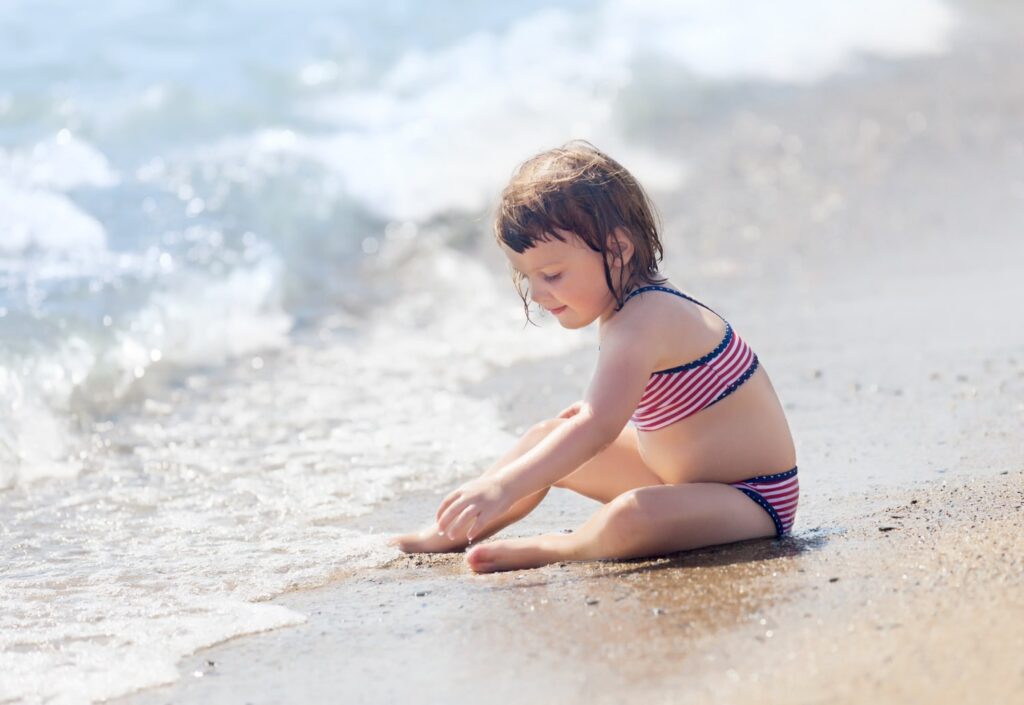Why Baby Sunscreen Safety Matters

Your baby’s skin is up to 30% thinner than adult skin and contains significantly less melanin—the natural pigment that offers some UV protection. This makes infants particularly vulnerable to the harmful effects of UVA and UVB rays. Without proper protection, babies can quickly develop sunburn, dehydration, and are at higher risk for future skin damage.
When to Start Using Baby Sunscreen
According to the American Academy of Pediatrics (AAP), you should:
- For babies under 6 months: Avoid direct sunscreen application when possible. Their delicate skin may absorb chemicals that could disrupt their skin’s pH balance or cause contact dermatitis.
- For babies 6 months and older: Apply sunscreen regularly when outdoors.
How to Choose the Right Baby Sunscreen
Not all sunscreens are created equal, especially when it comes to baby sunscreen safety. Here’s what experts recommend:
Physical vs. Chemical Sunscreens
Best choice: Physical (mineral-based) sunscreens
- Create a physical barrier on skin’s surface
- Start working immediately upon application
- Less likely to cause skin irritation
- Main active ingredients: zinc oxide or titanium dioxide
Avoid: Chemical sunscreens
- Contain potential hormone disruptors like oxybenzone and octinoxate
- Absorb into the skin rather than sitting on top
- May cause irritation in sensitive skin
Key Features to Look For:
- SPF 30 or higher
- “Broad spectrum” protection (blocks both UVA and UVB rays)
- Water-resistant formula
- “Baby-safe” or “hypoallergenic” labeling
- No added fragrances or dyes
- Dermatologist-tested
Proper Baby Sunscreen Application Techniques

For Babies Under 6 Months:
- Use sunscreen minimally and only when shade or protective clothing isn’t available
- Apply small amounts only to exposed areas
- Perform a patch test first to check for reactions
For Babies 6 Months and Older:
- Apply generously 15 minutes before sun exposure
- Use approximately 1 ounce (enough to fill a shot glass) for full-body coverage
- Don’t forget often-missed spots: ears, tops of feet, back of neck, scalp
- Reapply every 2 hours, or immediately after swimming or excessive sweating
- Be careful around eyes and hands to prevent accidental ingestion
Application Forms: Which to Choose?
Recommended:
- Sunscreen creams (provide even coverage)
- Sunscreen sticks (good for face application)
Not recommended:
- Spray sunscreens (inhalation risk)
- Powder sunscreens (inhalation risk)
Complete Sun Protection Strategy for Babies

Effective baby sunscreen safety goes beyond just applying sunscreen:
1. Protective Clothing
- Lightweight, full-coverage clothing
- UPF-rated fabrics when possible
- Wide-brimmed hats that shade face, ears, and neck
2. Timing Is Everything
- Avoid outdoor activities between 10 a.m. and 2 p.m.
- Plan outdoor time during early morning or late afternoon
- Check the UV index before heading outside
3. Create Shade
- Use strollers with sun-protective canopies
- Bring portable sun shelters to beaches or parks
- Seek natural shade from trees when available
4. Eye Protection
- UV-blocking sunglasses designed for babies
- Wrap-around styles provide better protection
- Look for impact-resistant lenses
Emergency Response: Dealing With Baby Sunburn
Despite best efforts, sunburns can happen. If your baby’s skin becomes red or inflamed:
- Move to shade immediately
- Apply cool (not cold) compresses to affected areas
- Keep baby hydrated
- Consider an infant-safe moisturizer with aloe vera
- Consult your pediatrician, especially if:
- Your baby is under 12 months
- The sunburn is severe or blistering
- Your baby develops a fever or excessive fussiness
Final Thoughts on Baby Sunscreen Safety
Protecting your little one from harmful UV rays doesn’t mean avoiding the outdoors altogether. With proper baby sunscreen safety practices and additional protective measures, you can create wonderful sun-filled memories without risking your baby’s delicate skin.
Remember that sun protection is a year-round necessity—UV rays can cause damage even on cloudy days or during winter months. By making sun protection a consistent habit, you’re not only preventing immediate sunburn but also reducing your child’s lifetime risk of skin damage and skin cancer.
Have you found effective ways to keep your baby protected in the sun? Share your tips in the comments below!
FAQ About Baby Sunscreen Safety
Can I use adult sunscreen on my baby?
No. Adult sunscreens often contain ingredients that may irritate baby’s sensitive skin. Always choose products specifically formulated for infants.
How long does baby sunscreen last?
Most sunscreens remain effective for about 12 months after opening. Check the expiration date and replace annually.
Is SPF 100 better than SPF 50 for babies?
Not significantly. SPF 50 blocks about 98% of UVB rays, while SPF 100 blocks about 99%. Focus more on frequent reapplication than extremely high SPF numbers.
Can babies get sunburned through clothing?
Yes, especially through lightweight, loosely woven fabrics. Consider UPF-rated clothing for maximum protection.
Is mineral sunscreen worth the higher cost?
For babies, yes. Mineral sunscreens reduce chemical exposure and are less likely to cause skin irritation, making them worth the investment for sensitive baby skin.
Reference :
A Sunny Start: Baby Sunscreen Tips Every Parent Should Know
Also Read :
Your Baby Skincare Routine Guide for the Tender Years (0-2 years) : Nurturing Every Touch



